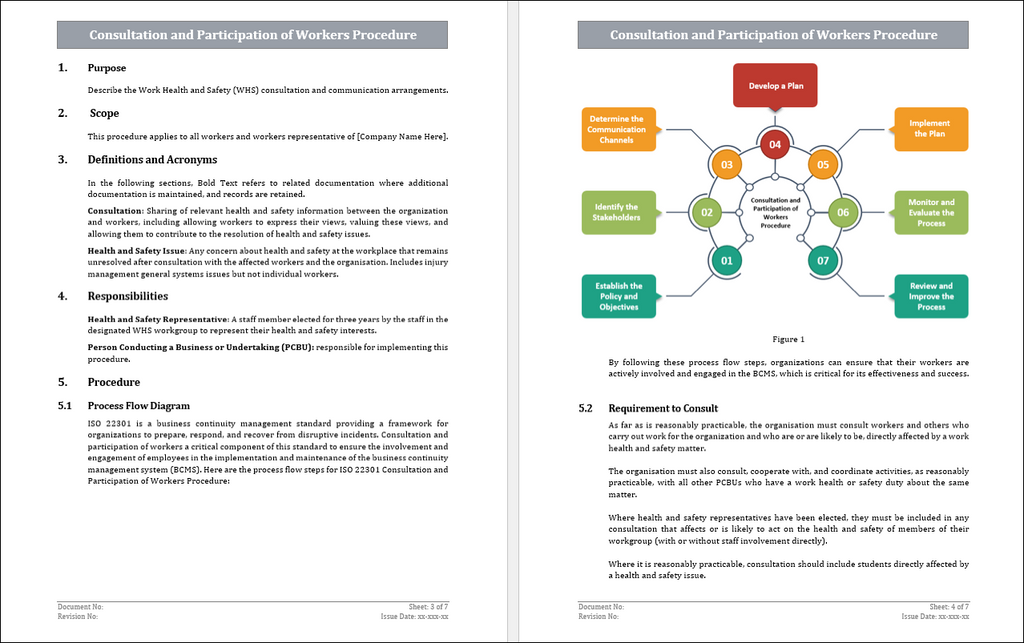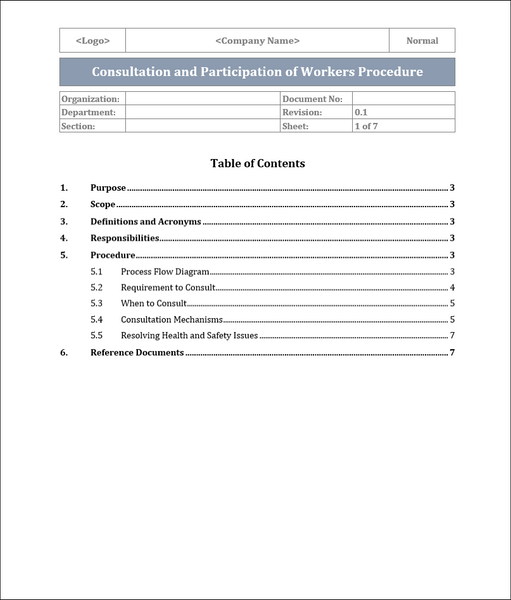ISO 45001 Consultation And Participation Of Workers Procedure Template
Introduction
The Consultation and Participation of Workers Procedure is essential to the ISO 45001 standard. It outlines the steps and processes that an organization must follow to ensure effective communication and involvement of workers in matters related to occupational health and safety. This procedure provides a template that can be customized to suit an organization's specific needs, helping them meet the requirements of ISO 45001. In this article, we will explore the critical elements of the Consultation and Participation of Workers Procedure template and how it can be implemented to enhance worker involvement and create a safer work environment.

Significance Of Worker Consultation And Participation In ISO 45001
Worker consultation and participation are crucial to ISO 45001, the international occupational health and safety management system standard. The significance of worker consultation and participation lies in several key aspects. Worker consultation ensures that employees are actively involved in the decision-making processes regarding health and safety in the workplace. This involvement allows workers to provide valuable input based on their firsthand experience and knowledge.
Their insights can help identify potential hazards, suggest improvements, and contribute to developing and implementing effective control measures. Moreover, worker participation fosters a sense of ownership and responsibility among employees regarding their own health and safety and that of their colleagues. When workers feel valued and empowered to voice their concerns, they are more likely to actively contribute to maintaining a safe and healthy work environment.
Furthermore, worker consultation and participation promote transparency and open communication within an organization. Employers can foster trust and build effective relationships based on mutual respect by engaging workers in discussions and decision-making processes. This enables better cooperation between management and employees, enhancing the implementation and effectiveness of health and safety policies and programs.
Monitoring And Evaluating The Effectiveness Of The Consultation And Participation Of Workers Procedure
1. Clearly Defined Objectives: The first step in monitoring and evaluating the effectiveness of the Consultation and Participation of Workers Procedure is to establish clear objectives. This includes identifying the goals and expectations of the consultation and participation process.
2. Data Collection: A comprehensive monitoring and evaluation plan should include data collection methods to assess the procedure's effectiveness. These may include surveys, interviews, and document analysis to gather information about workers' perceptions and experiences and their participation in decision-making processes.
3. Stakeholder Feedback: Gathering feedback from all stakeholders involved in the consultation and participation process is crucial for evaluating its effectiveness. This includes engaging with workers, managers, HR representatives, and other relevant parties to understand their perspectives on the procedure's effectiveness.
4. Compliance Assessment: Evaluating the extent to which the consultation and participation procedure is being implemented as intended is essential to monitoring its effectiveness. This involves assessing whether relevant policies, guidelines, and legal requirements are being followed and whether workers are provided with adequate consultation and participation opportunities.
5. Measuring Outcomes: Monitoring the outcomes of the consultation and participation process is critical to evaluating its effectiveness. This includes assessing whether the procedure has led to tangible improvements, such as increased worker satisfaction, reduced grievances, or improved decision-making processes.
6. Continuous Improvement: Monitoring and evaluation should be seen as something other than a one-time activity. Regularly reviewing the procedure's effectiveness and adjusting based on the findings is crucial for continuous improvement. This may involve revisiting objectives, refining implementation strategies, and incorporating stakeholder feedback.
7. Reporting And Communication: Finally, it is essential to communicate the monitoring and evaluation process findings to all relevant parties. This includes sharing the results with workers, managers, and other stakeholders and developing an action plan based on the findings to address any gaps or areas for improvement identified during the evaluation.

Benefits Of Using The ISO 45001 Compliance Evaluation Record
1. Standardization: ISO 45001 Compliance Evaluation Record provides a standardized framework for evaluating compliance with the Occupational Health and Safety Management System (OHSMS) requirements. This ensures that all organizations follow the same assessment criteria and can be easily compared.
2. Identified Gaps: The evaluation record helps identify gaps or non-compliance with the ISO 45001 standard. This allows organizations to take corrective actions and implement necessary measures to ensure compliance and prevent accidents or occupational hazards.
3. Continual Improvement: By regularly evaluating compliance with ISO 45001 requirements, organizations can identify areas for improvement. This promotes a culture of continuous improvement and helps enhance the effectiveness of the OHSMS.
4. Enhanced Health And Safety Standards: ISO 45001 Compliance Evaluation Record helps organizations assess their compliance with the ISO 45001 standard, specifically designed for occupational health and safety management systems. By using this record, companies can ensure that their health and safety standards are up to par, leading to a safer and healthier work environment for employees.
5. Improved Risk Assessment: The compliance evaluation record allows organizations to identify potential health and safety hazards in the workplace. By conducting a proper evaluation, companies can assess risks and implement adequate controls to mitigate those risks. This proactive approach helps prevent accidents or incidents and minimizes the negative impact on employees and the business.
6. Legal Compliance: ISO 45001 compliance is often a legal requirement for organizations, depending on the industry and country. Organizations can use the compliance evaluation record to demonstrate their commitment to meeting legal requirements and industry regulations, thus avoiding penalties or legal issues.
Conclusion
In summary, the Consultation and Participation of Workers Procedure for ISO 45001 template is essential for organizations looking to implement effective worker involvement in health and safety management systems. This template provides a clear and structured approach to consulting and involving workers, ensuring compliance with ISO 45001 standards. Organizations can use this template to enhance worker participation, improve health and safety outcomes, and ultimately create a safer and more productive work environment. The next step in advancing your organization's safety practices is implementing the Consultation and Participation of Workers Procedure for ISO 45001 template.


